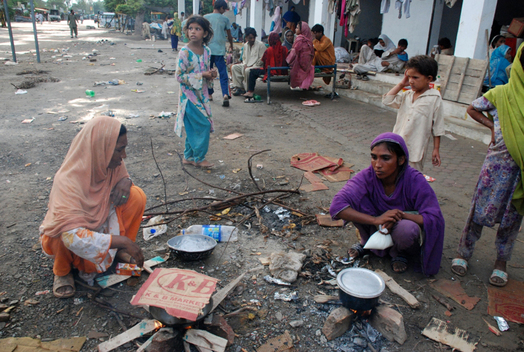
The number of people affected in the flooding related disaster has climbed to almost 20 million. If the people in less badly affected areas are added the number reaches 30 million. The floods caused immense damage both in northern and southern regions. The recovery of the South is estimated to take months. According to official figures the death toll is 1,539 and the number of injured is 2,055.
The Pakistan floods, one of the worst in history by affected area, have nearly damaged half of the nation’s farmlands. The perishing of 300,000 small and large head of cattle has brought about the risk of a long-term famine.
The worst affected regions are Baluchistan, Punjab, Khyber Pakhtunkhwa, and Sindh. Access and aid delivery to these regions is only possible by search and rescue helicopters and aircrafts since highways and railways are mostly inundated.
The disaster has left 30m people with no homes and food. As the flood waters begin to retreat slowly the risk of epidemic diseases especially cholera is spreading.
About 1.3 million people have been made homeless, while military search and rescue helicopters are evacuating victims from flooded areas, reports say.
Aid agencies working in the region are experiencing major difficulties. Accessing the affected areas seems to be the biggest problem. Victims in need of food and water sometimes throng to aid distribution stations, raising the risk of stampede and ransack.
Turkey, the United States, Saudi Arabia, Iran and the United Nations as well as other countries are sending aid supplies such as food, medical supplies, shelters and cash donations.
Children are the worst hit by the flooding in Pakistan, a country with a population of 180 million. Children are facing epidemic diseases in regions with shortages of clean water, food, and medication. To see the bigger picture of disaster, one has to look at all aspect of damage.
Agriculture
Plantations of Pakistan’s staple crops such as rice, barley and wheat are entirely inundated. Since thousands of tons of seeds in depots have been destroyed, Pakistan is likely to face serious famines in 2011-2012 unless it receives seed stocks in the coming seed time. Official reports indicate that 600,000 tons of seed stocks have been washed away by the flood waters. Agricultural equipment and machinery in the 5,000 villages inundated have been badly damaged and are in no condition to be used.
Education
In the six provinces hit by the flooding 7,820 schools were either entirely destroyed or badly damaged. Only 4,935 schools are being used as shelter for the victims. Rendering damaged schools ready for upcoming school year or as shelters will require huge aid effort.
Health
The number of people catching epidemic diseases is rising. Only 1.5 million out of the 20 million affected people have undergone health screening so far, official figures show.
The screening process revealed that 200,000 victims have diarrhea, 263,000 have skin diseases, and 204,000 have respiratory tract diseases.
There are about 960,000 pregnant women and women with babies in the affected areas. Almost half of the to-be-born babies are at the risk of death. About one million children under the age of three are having malnutrition problems.
Shelter-Transport-Communication
The floods destroyed 1,226,000 houses. The residents who lost their homes are staying in dry places or in camps with primitive conditions. Although 5,000 schools have been opened to victims as shelters, only 37 percent of the affected people have a place of accommodation. Almost all transport and communication links with floodplains have been severed and made useless. The fate of people in southern provinces where flood waters have surged drastically is not known.
Necessities
The 20 million people affected by the flooding need daily supplies of food. In parts of the country not affected by the flooding food stocks are declining since stocks have been transferred to affected regions. It is vital that emergency food aid continues without delay and interruption.
Feeding babies and children is the most serious part of food aid. It is important that children get clean food because they have a high risk of developing infections.
Since epidemic diseases most easily spread via unhealthy drinking water, survivors’ access to clean drinking water carries enormous importance.
One million homeless people need temporary shelters and permanent dwellings once flood waters have retreated. Pakistan, in this regard, is in need of construction materials.
Flood victims are going to need seeds, fertilizers and tractors to re-cultivate their lands once farmlands recover from flood waters.
Further needs:
- Lasting foodstuffs and pulses
- Canned meat and fish
- Infant formula
- Clothes
- Tents
- Canvas
- Medication
- Generator
- Drinking water purifiers
- Water pumps
- Medical tools and equipment
- Cleaning materials
- Kitchen utensils (metallic tools)
- Diapers
- Sanitary pads
To treat diarrhea, cholera, malaria and skin diseases that are widely reported in the flooded regions the following medicines are urgently needed:
- Diarrhea medicines
- Malaria medicines
- IV bags
- Cleaning kits